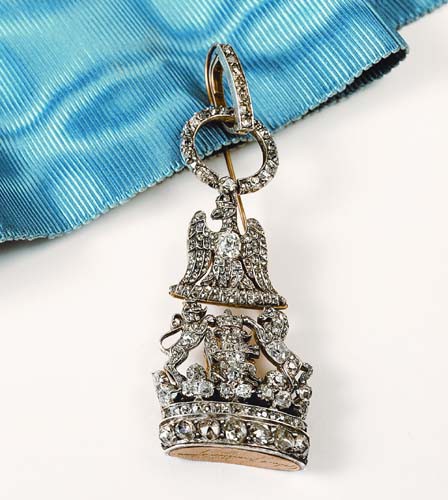Following the Treaty of Tilsit, Napoleon created the Kingdom of Westphalia for his youngest brother, Jerome Bonaparte. The kingdom was made up of a number of German territories, with Kassel becoming the capital for the newly-created state. Jerome became Jerome Napoleon and was proclaimed king on 7 July 1807, eventually arriving in the capital on 7 December of the same year. Jerome was extravagant, enjoyed the splendour of the royal court and very early on sought to found his own royal order. He was however forced to wait two years for his brother to sign the decree that would authorise the creation of the order, an act that was completed on 25 December 1809.
Modeled on the Légion d'honneur, the Order of the Crown of Westphalia was to be both a military and civil award. There were to be ten 'grand commandeurs', thirty 'commandeurs', three-hundred 'chevaliers de première classe' and five-hundred 'chevaliers de seconde classe'. The king, as 'grand maître' of the Order, wore a collar and an insignia studded with diamonds, which suggests that this insignia belonged to him. It is signed “GIBERT joaillier à PARIS” and bears the inscription “ERRICHTET DEN XXV DEC MDCCCIX” (established 25 December 1809). The first decorations were created by the ever-present Biennais, but later examples were commissioned from other Paris jewellers such as Gibert and Oliveras, and even from goldsmiths in Kassel. The upper section comprises a crowned imperial eagle; the supporters, a crowned lion (Kassel) and a horse (Westphalia) frame a demi-eagle and demi-lion, which share a single crown. The decoration's nickname of 'menagerie' is hardly surprising given the abundance of beasts and animals incorporated in the design! The ribbon is a rich blue, the royal colour of the Kingdom of Westphalia. The order did not survive the fall of the kingdom in 1813, but Jerome continued to wear his insignia until his death in 1860, long into the Second Empire! The cross remained in the family and was passed down to Jerome's great grand-daughter, the Countess de Witt, born Marie-Clothilde Napoléon (1912-1996). The cross went on sale in London on 12 July 1994 and was acquired by the Fondation Napoléon. Another cross created by Gibert, this time in gold, enamel and pearls, which also belonged to the imperial family, is held at the Musée de Fontainebleau.
Bernard Chevallier (tr. H.D.W.)
Conservateur général du patrimoine (emeritus)
November 2008
Cross of the Order of the Jerome Bonaparte Crown of Westphalia
Artist(s) : GIBERT H.-J.

- Date :
- Around 1810
- Technique :
- Yellow and white gold, diamonds, enamel
- Dimensions :
- H = 6.5 cm
- Place held :
- Paris, Fondation Napoléon
- Photo credit :
- © Fondation Napoléon

